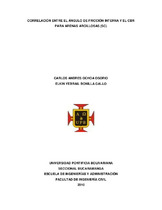Mostrar el registro sencillo del ítem
Correlación enttre el ángulo de fricción interna y el CBR para arenas arcillosas (SC)
| dc.contributor.advisor | Director. Bautista García, Gerardo | |
| dc.contributor.author | Bonilla Gallo, Elkin Yebrail | |
| dc.contributor.author | Ochoa Osorio, Carlos Andres | |
| dc.coverage.spatial | Seccional Bucaramanga. Universidad Pontificia Bolivariana. Escuela de Ingenierías. Facultad de Ingeniería Civil | spa |
| dc.coverage.temporal | 2010 | |
| dc.date.accessioned | 2014-01-14T15:45:02Z | |
| dc.date.available | 2014-01-14T15:45:02Z | |
| dc.date.issued | 2014-01-14 | |
| dc.identifier.uri | http://hdl.handle.net/20.500.11912/1362 | |
| dc.description | 55p.: (pdf); il; gráficas; tablas; anexos | spa |
| dc.description.abstract | El presente trabajo de grado, tuvo como propósito hallar la correlación entre el ángulo de fricción interna y el CBR tipo I. Para dar cumplimiento a este objetivo se realizaron 90 ensayos de CBR tipo I y 90 de corte directo con diferentes valores de humedad (30 con la humedad óptima, 30 con cuatro puntos porcentuales por debajo de la humedad óptima y 30 con cuatro puntos porcentuales por encima de la humedad óptima). Este trabajo se empezó con la ubicación del sitio en el cual se obtuvieran muestras de arena arcillosa, una vez ubicado el material a estudiar se procedió a realizar los ensayos de clasificación tales como granulometría y límites de Atterberg, obteniendo que el material era una arena arcillosa (SC), la cual fue extraída del costado norte de la cancha de futbol de la Universidad Pontificia Bolivariana, luego se procedió a hallar la humedad óptima y el peso específico seco máximo del material con la prueba de proctor modificado para finalmente realizar los ensayos de CBR tipo I y corte directo con las humedades ya mencionadas. Finalmente con los resultados obtenidos se procedió al análisis de estos mismos dando como resultado una serie de tendencias que fueron analizadas para dar conclusiones y recomendaciones teniendo en cuenta que el objetivo principal de esta tesis era la correlación entre el ángulo de fricción interna y el CBR tipo I. | spa |
| dc.description.abstract | This degree project, aimed to find the correlation between the angle of inner friction and the CBR type I. To achieve this goal, 90 CBR type I rehearsals were made and other 90 of direct cut with different values of humidity (30 with optimal humidity, 30 with four percental points under the optimal humidity and 30 with four percental points above the optimal humidity. This work started by finding the place where the samples of clay sands were found, once it was located the classification tests were made, such as grain size distribution and Atterberg limits, the material was found in the north side of soccer court of Universidad Pontificia Bolivariana, then the optimal humidity and the specific dried maximal weight of the material was found with the test of modified proctor to finally made the test of CBR type I and direct cut with the humidity mentioned before. Finally the results were analysed and a series was studied to give conclusions and recommendations, taking into account that the principal aim of this thesis was the correlation between the angle of inner friction and the CBR type I. | |
| dc.language.iso | spa | |
| dc.publisher | Universidad Pontificia Bolivariana | spa |
| dc.rights | Attribution-NonCommercial-NoDerivatives 4.0 International | * |
| dc.rights.uri | http://creativecommons.org/licenses/by-nc-nd/4.0/ | * |
| dc.subject | Granulometría | spa |
| dc.subject | Correlación de perspectiva en geología | spa |
| dc.subject | Tesis y disertaciones académicas | spa |
| dc.subject | CBR | spa |
| dc.title | Correlación enttre el ángulo de fricción interna y el CBR para arenas arcillosas (SC) | spa |
| dc.type | Trabajo de grado | spa |
| dc.rights.accessRights | openAccess | spa |
| dc.type.hasVersion | publishedVersion | spa |
| dc.identifier.instname | instname:Universidad Pontificia Bolivariana | spa |
| dc.identifier.reponame | reponame:Repositorio Institucional de la Universidad Pontificia Bolivariana | spa |
| dc.identifier.repourl | repourl:https://repository.unab.edu.co/ |
Ficheros en el ítem
Este ítem aparece en la(s) siguiente(s) colección(ones)
-
Trabajos de grado [6698]
Monografías, artículos, informes, proyecto de grado


